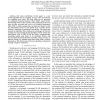Free Online Productivity Tools
i2Speak
i2Symbol
i2OCR
iTex2Img
iWeb2Print
iWeb2Shot
i2Type
iPdf2Split
iPdf2Merge
i2Bopomofo
i2Arabic
i2Style
i2Image
i2PDF
iLatex2Rtf
Sci2ools
96
Voted
ICRA
2006
IEEE
2006
IEEE
Mapping Large Scale Environments using Relative Position Information among Landmarks
— The main contribution of this paper is a new SLAM algorithm for the mapping of large scale environments by combining local maps. The local maps can be generated by traditional Extended Kalman Filter (EKF) based SLAM. Relationships between the locations of the landmarks in the local map are then extracted and used in an Extended Information Filter (EIF) to build a global map. An important feature is that the information matrix for the global map is exactly sparse, leading to significant computational advantages. This paper thus presents an algorithm that combines the advantages of both the existing local map joining SLAM algorithms, which reduces the linearization error in EKF SLAM and allows computationally demanding global map fusion to be scheduled off-line, and the Decoupled SLAM (D-SLAM) algorithm, which provides an efficient strategy for building large maps using relative location information. The effectiveness of the new algorithm is illustrated through computer simulations...
Global Map | ICRA 2006 | Local Map | Robotics | Slam Algorithms |
Related Content
| Added | 11 Jun 2010 |
| Updated | 11 Jun 2010 |
| Type | Conference |
| Year | 2006 |
| Where | ICRA |
| Authors | Shoudong Huang, Zhan Wang, Gamini Dissanayake |
Comments (0)

